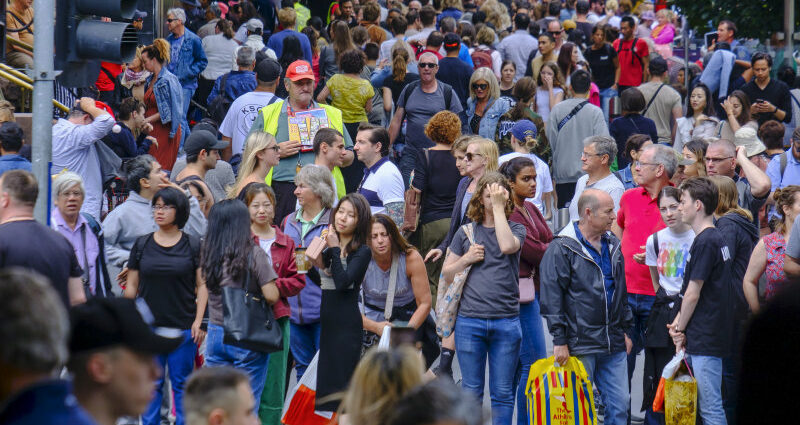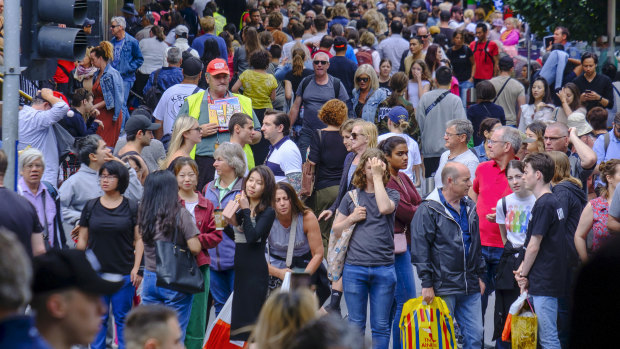Since the first boatloads of convicts were brought to Australia against their will at the end of the 18th century, we’ve been a country of immigrants.
Into the future, migration will play a decisive role in how our nation continues to grow and age. Without it, we’ll be economically much worse off.
Migration is key to Australia’s future.Credit:Luis Ascui
I’ll put my stake in this up front: three out of four of my grandparents arrived in Australia via boats in the great post-war shift that brought migrants from mostly European countries, including the UK, Greece and Italy.
Since then, migration has continued to shape our country, culturally and economically. And as the Australian birthrate continues its seemingly inexorable downward trend, migration will be vital for the country’s future.
Let’s leave aside the high-level arguments around how a growing population contributes to economic growth, and whether that is a good measure of success, but instead look at some of the practicalities of either a growing or shrinking population.
Australia’s birthrate has been in steady decline for about half a century. Today women have on average 1.66 babies, below the rate of 2.1 babies per woman, which is required for a generation to replace itself.
That means Australians are getting older. According to the recently published 2022 Population Statement from the government’s Centre for Population, the median age is expected to reach nearly 43 by 2060-61 if the baseline fertility scenario holds. Under that scenario, the fertility rate will gradually fall to 1.62 by 2030-31 and continue its downward trend.
By 2060-61, the government expects the population to reach 39.2 million. The report says that natural increase (that is, total births minus total deaths) under the baseline fertility scenario would contribute to a quarter of expected population growth – the rest would be driven by overseas migration.
That scenario projects 23 per cent of the population to be aged 65 or over by 2060. As of 2020-21, nearly 17 per cent of Australia’s 25.7 million people were over 65.
But if you take migration out of the picture, we get a very different nation. Assuming the number of people moving to Australia equals the number of people leaving, Australia’s median age by 2060 will reach 46.6, and 28.7 per cent of the population – nearly a third – would be aged over 65.
This would have profound effects on the cost of health, aged care and age pensions.
The 2021 Intergenerational Report points out that population ageing will reduce the number of people in the workforce, meaning fewer people paying income tax.
“This presents long-term economic and fiscal challenges, similar to those faced in most comparable countries,” the report noted.
Migration slows this ageing effect down because migrants are typically younger. In many cases, they move to Australia for study and then stay on as skilled migrants.
According to the Grattan institute, skilled migrants “tend to be younger, higher-skilled, and earn higher incomes than the typical Australian”. They are also more likely to work full time, compared to the general Australian population, and are increasingly likely to be highly educated.
Those workers pay taxes in Australia, which helps fund our health and aged care services which are only becoming more expensive as the nation ages. They also spend money here, helping to keep the economy ticking, and other people in various jobs.
I’ve had plenty of correspondence in the past week from people who don’t like the idea of Australia taking in more migrants. Won’t that just add to our ageing problem in the future? What about the amount of housing, or infrastructure including roads?
The government does need to ensure there is enough infrastructure to support our growing population, and the Intergenerational Report noted that migration was not a complete solution and should be well managed to keep Australia’s high living standards.
But what happens if we don’t take in enough migrants? There are lessons here from the country with the oldest population – Japan. Their fertility rate is 1.33, according to the OECD, and their median age 48.7 and growing towards 54.7 by 2050.
The government there fears a growing wave of business closures as owners reach retirement age with no one to replace them despite healthy earnings, as highlighted in a recent New York Times article. Key businesses there could close, as even many workers who could potentially take the reins near retirement themselves.
That is just one example of the risks faced by an ageing country.
After my grandparents arrived in Australia, they became respectively a cook, train driver and a school principal. Between them, they had five children and more than a dozen grandchildren, who have had jobs as varied as artists, veterinarians, doctors, social workers, and yes; one journalist.
In their small way, my grandparents came to Australia and made the most out of their new circumstances and what this country has to offer. It’s people like them who will help shape the future.
Fascinating answers to perplexing questions delivered to your inbox every week. Sign up to get our new Explainer newsletter here.
Most Viewed in Business
From our partners
Source: Read Full Article
-
U.S. Private Sector Job Growth In September The Slowest Since January 2021
-
Treasury seeks legal advice on PwC tax leaker
-
Cat litter and yoghurt: What a journalist on $63,500 spends in a week
-
These 7 Stocks Touched New Highs Yesterday – Did You Ride The Momentum?
-
How to fight back against soaring airfares


